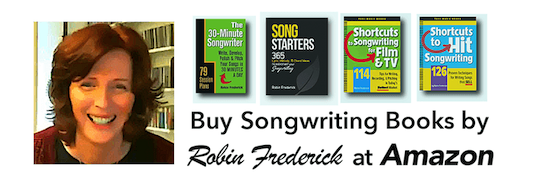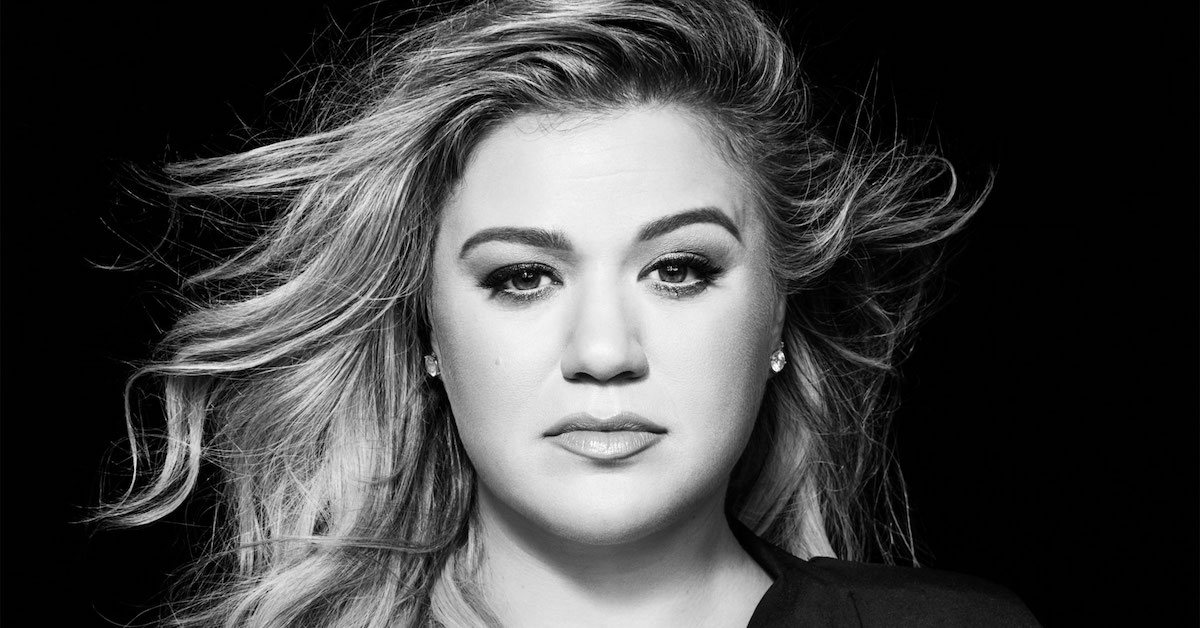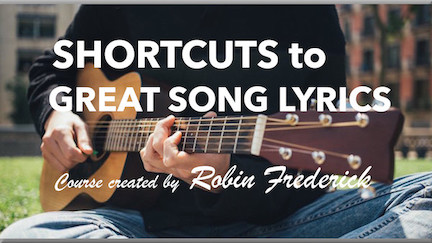This is just the kind of song that every American Idol finalist and semi-finalist hungers for—and so do record labels and publishers. The melody has a huge range, which works well for singers with big voices, and there’s plenty of passion and excitement in the lyrics. If you’re interested in today’s melodic Pop/Rock genre, this is a song that’s worth studying. It offers a master class in contemporary melody and lyric craft.
Watch on YouTube.
Read the lyric here.
The Shortcut numbers refer to specific chapters in my books “Shortcuts to Hit Songwriting” (“Hit”) and “Shortcuts to Songwriting for Film & TV” (“Film/TV”).
Recorded by Kelly Clarkson
Writers: Jörgen Elofsson, Ali Tamposi, David Gamson, Greg Kurstin.
GENRE (Pop/Rock, Pop Dance)
This is a great Pop/Rock song that went to #1 on Billboard’s Adult Contemporary (AC) chart. It also made it into the top ten on the Hot 100, Pop, and Dance Club charts. It has enough pumping beat to work in the Dance Clubs and enough lyric depth and craft to make it stands alone as a Pop/Rock song. It’s a great combination.
SONG STRUCTURE
At 3:42, the song is on the long side, but once it gets rolling, there’s no stopping it! The basic song structure is
VERSE / FULL PRE-CHORUS / CHORUS
VERSE / HALF PRE-CHORUS / CHORUS
BRIDGE / CHORUS / REPEAT 2nd HALF OF CHORUS
The verses in this song are short, just four lines. This is a good thing because the chorus (beginning with the line “What doesn’t kill you makes you stronger”) is quite long. It’s double the length we would expect, repeating the phrase “What doesn’t kill you…” four times in each chorus – that’s fourteen times before the song is over!
The first pre-chorus section starts with the line “You think you got the best of me.” After the second verse, the pre-chorus starts with “You heard that I was starting over.” Both sections build intensity and anticipation going into the chorus by raising the note range of the melody and picking up the pace of the notes and words.
Notice that the second pre-chorus is only half the length of the first. By this time, the writers just want to get us to that powerhouse chorus. (For more on writing a strong pre-chorus read “Hit” Shortcuts #26 and #86.)
The bridge is four lines starting with “Thanks to you…” It provides a peak moment in which the singer clearly reveals the message behind the song with plenty of attitude and strength.
Try It Now
Watch the video again and notice where each song section begins. See if you can identify the verses, chorus, pre-choruses, and bridge . Find out more about Song Structure in my songwriting blog.

LYRICS
In this genre lyrics are honest and conversational. It sounds like the singer is speaking directly to the “you” of the song. But just because it’s straightforward doesn’t mean a lyric has to be bland or generic. This is one of the great tricks of good Pop/Rock lyric writing
The very first line provides a strong setup: “You know the bed feels warmer / sleeping here alone.” This is a great image and creates a twist, something we don’t expect. Really? The bed is warmer when you’re sleeping alone? Listeners are curious so they’re immediately drawn into the song.
The first pre-chorus is a string of accusations that tell us why the singer feels so strongly: “You think you got the best of me / Think you had the last laugh.” Very important for listeners because we need to know that the singer isn’t just being spiteful – she has a real reason to feel the way she does.
Notice how the writers give us a clear picture of what has happened without ever saying “I was in a bad relationship” or “I don’t love you anymore.” It’s all done in authentic, in-the-moment dialogue.
After the direct, conversational pre-chorus, the chorus lyric includes a lot of vivid action words and images. Words like “stronger” “stand” and “fighter” immediately suggest power and strength. An unexpectedly poetic phrase like “makes a fighter’s / footsteps even lighter” is a poetic image that expresses a fresh way of looking at adversity. (For more on using images, read “Hits” Shortcuts #57 though #60.)
Most importantly, the chorus explains the first line of the verse! Finally we know: The bed is warmer because she’s feeling stronger and happier now that she’s alone. This kind of consistent, cohesive build from the verse to the chorus keeps the listener involved, giving the song a sense of emotional integrity and truth.
If you write your verse first, then look to your opening line when you begin to construct your chorus. If you write your chorus first, then make certain you create an opening verse line that supports it. In a song, every line is connected to every other line!
Try It Now
Read through the lyric or watch the video again and notice how each verse lyric supports and leads to the chorus.
MELODY / CHORDS
NOTE RANGE: The melody builds from a low note range in the verse to soaring high notes in the chorus. This type of melody requires a powerhouse singer with a huge vocal range. If you’re writing a song to pitch to finalists on The Voice or American Idol, you can be certain they’ll want a melody just like this – one that lets them show off their chops!
USE PACE TO CREATE CONTRAST: Each section of this melody – verse, pre-chorus, and chorus – is defined by a change of pace. The speed of the notes and words changes in each section, setting it apart from the other sections.
For example, in the verse, words are held out at the ends of lines (“warmer,” “alone,” “color,” “want”) and there are pauses between lines for a breath; the pace is pretty relaxed. In the pre-chorus, the pace of the notes and words picks up. Instead of a steady march, suddenly there are quick, packed-together phrases at the beginnings of lines (“You think you got…”) and the lines and pauses are shorter than in the verse melody. The pace has increased as the song builds to the chorus, creating a sense of anticipation and excitement.
Although the chorus melody features a steady, even beat (like the verse), notice that there are almost no pauses at all between or during lines. This is great way to add a feeling of forward moment to a melody, create a sense of emotional urgency and keep your song rolling forward! (“Hits” Shortcut #92)
EXTRA TIP: Notice how the song moves from the end of chorus right into the beginning of Verse 2. There’s no pause or break for an instrumental – the song keeps moving. This is often the case in today’s big Pop hits. They don’t give the listener any opportunity to lose interest and maybe change the radio station!
Try It Now
Watch the video again and notice how the melody changes pace between the verse, pre-chorus, and chorus. Try writing or rewriting a chorus melody that moves forward with very few pauses, as this one does.
PRODUCTION
This song has a glossy, contemporary production that’s typical of hits by Clarkson, Katy Perry, P!nk, etc. To pitch a song in this style to a publisher, you need a good demo that conveys the radio-friendly, energetic, emotional feel of your song.
Give the drums a lot of care and attention. Unless you really know how to handle drum programming, I recommend using one of the session drummers who offer online tracks. There’s a list of drummers in Shortcut #81 of my book “Shortcuts to Hit Songwriting,” or you can check out the Resources page. Be sure to give the drummer a recent hit song as a reference for the drum style and sound you want.
A good vocalist is a must-have for this type of demo. If you’re not a strong singer yourself, try one of the vocalists at www.StudioPros.com. Find out the singer’s note range then make sure your track is in the right key so that the melody falls within his or her range. Give the singer a very clear version of your melody. If you can’t sing it on pitch, play the lead vocal melody on keyboard.
Be sure to make an instrumental mix of your song (mute all lead vocals and backup vocals). If you need to make changes later on, you can just re-record the vocal.
This type of demo can get expensive. Don’t invest money in your demo until you’re sure you have a solid, contemporary song. Compare your lyrics and melody to a song like “Stronger (What Doesn’t Kill You).” Then try to beat what you already have. If you come up with better lines, use them; if not, then stick with what you’ve got. But don’t stop writing until you’ve pushed the song as hard as you can.
Try It Now
Watch the video while paying close attention to the production. What instruments are playing? Where do they come in and drop out? Is the vocal featured throughout? How does the production build energy from verse to chorus?
LEARN THIS SONG
Print out the lyrics and listen to the song “Stronger (What Doesn’t Kill You).” Learn to sing along with the song one section at a time. You don’t have to hit all the notes! Just try to get a feel for the phrasing of the melody, changes in pace, and where the lines start.
If you’d like to learn to play this song you’ll find the chords here. This Youtube Video will show you how to play it on piano.
READ MORE SONG GUIDES ON THIS SITE and learn from the hits!
Song Guide by Robin Frederick

